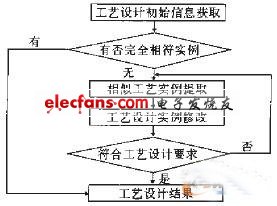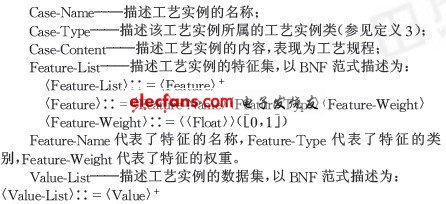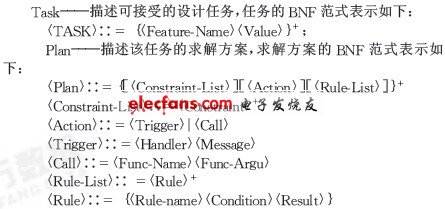1 Introduction This article refers to the address: http:// As a bridge and link for design and manufacturing, CAPP is not only the first step in the preparation of manufacturing enterprises, but also an important part of the company's cooperation. Due to the status and role of CAPP in CIMS, the automatic generation of process planning (also known as intelligent process design) is regarded as one of the key information technologies in production automation, and countries are competing to carry out application technology research. To this end, this paper from the perspective of human cognitive psychology, through the introduction of CBR (Case-Based Reasoning) technology, and organically combined with RBR technology, constructed an instance-based intelligent process design system, effectively solved Defects and shortcomings of traditional intelligent process design systems. 2 Instance-based intelligent process design system - CBIPP Cased-Based Reasoning (CBR) is a new type of reasoning technology developed on the basis of rule-based reasoning and model-based reasoning. It fully imitates the way humans think, and analyzes the specific problems that reasoning needs to solve at high speed and accuracy. CBR is actually a mapping process from the user request space to the instance space. Applying CBR technology to an intelligent process design system has the following advantages: (1) Make full use of the successful process design examples in the past, greatly improve the efficiency of process design, shorten the process design cycle of new products, reduce the human error in the process design process, and improve the correctness of the design; (2) Since the process examples themselves contain a large amount of experience in process design, the acquisition and expression of a large amount of knowledge can be saved; (3) Since each new process design result can be stored in the process instance library, the knowledge is expanded, and the system has certain self-learning ability; (4) From the perspective of human cognitive psychology, the case-based reasoning history conforms to the thinking process of the process designer, because the craftsperson always considers the previous design examples first when designing the process, and finds similar process design solutions. Modify it to get a new design (ie a new process example). The basic process of process design based on case-based reasoning techniques for new parts can be represented as the process shown in Figure 1. Figure 1 Process design flow chart based on case-based reasoning In this paper, the CBR technology and RBR technology are organically combined, and the overall structure of the Case-Paced Intelligent Process Planning System (CPIPP) system is shown in Figure 2. It consists of two modules. The highest level is an instance-based inference engine, which contains an instance library (a successful process design example); the system is detailed according to the process design (source process instance), and an instance-based inference engine returns a most similar instance from the instance library. (Target process example), the inconsistencies in the two process examples are reasoned by the rule-based inference engine, process knowledge base (rule library) and process database located in the first layer, thereby modifying the corresponding process design content in the target process instance. To meet the process design requirements, and finally complete the process design. Figure 2 Overall structure of the CBIPP system Figure 3 Formal description of the process example In the case-based intelligent process design system, the knowledge representation model of the process instance must fully and effectively express all kinds of knowledge required in the process design process to support the solution of process design problems. From the perspective of process design, the established knowledge expression model must include the design information of the part itself as well as the corresponding process urgency. Based on the above considerations, starting from the object-oriented thinking, this paper defines a process instance expression model for the variant process design, the basic definition is as follows: Definition 1 A process instance is a specific design result that meets certain process design requirements. A complete process instance (Case) can be represented as a five-tuple (Case-Name, Case-Type, Case-Content, Fea-lure-List, Value). -List). among them: There is a one-to-one correspondence between the data in the process instance data set and the features in the process instance feature set. In the same type of process example, each instance is distinguished from each other according to the characteristics of the examples. Definition 2 The process instance class (Case-Type) describes the classification information of the process instance, which can be expressed as an octet (Rough-Type, De-tail-Type, Material, Rough, Heat-Treat, Batch, Shape-Cuttin, CAPP-Agent). among them: Rough-Type - describes the big class of the process instance class, expressed as BNF paradigm: ::={0|1}, 0 represents a revolving body, and 1 represents a non-rotating body; Detail-Type - describes the subclass information of the process instance class; Turning represents the shape and processing properties of the rotary process example, and Not-Turning represents the shape and processing properties of the non-rotating process example. In the shape and processing properties of the rotary process example: Out-Type represents the external basic shape, Out-Function represents the external functional element, In-Type represents the internal basic shape, In-Function represents the internal functional element, and Out-Shape represents the outer plane. Or end face, In-Shape represents the inner plane, Assist-Function represents the auxiliary hole or forming scribe line; in the shape and processing properties of the non-rotating process example, Out-Typen represents the external basic shape, Shape-Cutting represents the plane machining, Cur -Cutting represents surface machining, Out-Attribute represents shape elements, Main-Hole represents main machining holes, In-Cutting represents internal machining, and Assist-Type represents auxiliary holes or forming. CAPP Agent - is a mapping set from process instance features to process instance content. See definition 3 for details. Definition 3 The Process Design Strategy (CAPP-Agent) describes the specific process design solution strategy for a particular process instance class, which can be represented as a two-tuple (Task, Plan). among them: Among them, the operations that need to be performed in the problem solving process are described, including the design task of sub-objects and the calling of various internal and external functions in the form of message passing; then the experience in the solving process is described in the form of production rules. Sexual reasoning rules. It can be seen from the above definition that the knowledge representation model of the process instance is centered on the layered framework structure and the object-oriented thinking, and has strong structural ability; at the same time, the complete and effective expression of the variant process design process is used. The various process design knowledge (described in the form of rules) supports the system based on rule-based reasoning to complete the modification of the process instance. 4 Process instance retrieval and matching 4.1 Process instance index The process instance index describes the unique flag for the process instance. Through the establishment of the process instance index, all process instances stored in the process instance library of the system can be uniquely determined. When the system uses instance-based reasoning, similar process instances can be quickly found based on external input conditions. Currently in artificial intelligence, there are three main types of instance indexing techniques: (1) The nearest neighbor method (Vearest Veighbor Approach). Its core idea is to retrieve instances using the sum of the input instance feature weights that match the instances in the instance library. This method is simple and practical, but since in most cases the weights of the features are different for each instance, it is difficult to determine a set of weights that apply to all instances. (2) Inductive Approach. It is a learning algorithm that uses a similar decision tree. In the classified instance, it is determined which feature of the instance has the best discriminating ability. The induction method is superior to the weight proximity method in that the retrieval target is clearly defined and each target type has enough examples to summarize, and the disadvantage is that a large number of instances are needed for induction. (3) Knowledge-Paced Retrieval Approach. It is to use the instance knowledge in the instance library to determine which features of the instance are important. This method is very suitable when the source of knowledge is appropriate. Its disadvantage is that it is often difficult to perform a full knowledge-based indexing of a wide range of input facts. The CBIPP system adopts an object-oriented instance indexing mechanism based on the above three methods, and establishes a two-level index: the first level index reflects the category of the process instance (Case-Type); the second level index reflects the same process instance. Differences in features. In addition, the system can also index based on features that affect the process instance problem solving. 4.2 Instance retrieval and instance matching Similar to the instance indexing technique, there are three types of instance retrieval strategies: (1) Hierarchical search is used together with the inductive index. The retrieval process is based on the classification decision tree formed by the inductive index, and the tree root begins to decline layer by layer until it cannot be lowered; (2) Association search, also known as proximity search, is used in conjunction with the weighted proximity index. The retrieval process is based on the similarity of the instance feature attributes defined in the weighted proximity index, and the new instance entered by the user is associated with the instance in the library. Comparison (3) Knowledge-based retrieval, which refers to the use of existing instance knowledge about the instance library to determine which instance attributes are important when retrieving instances. Similar to the establishment of the instance index, the CBIPP system adopts a combination of three object-oriented retrieval strategies. The algorithm process is as follows: 1 Obtaining process design initial information (ie source process instance information) through the human-machine interface; 2 According to the source process instance information, determine a process instance class (Case-Type), and obtain a set of all process instances of the hierarchy; 3 Call the instance matching algorithm to obtain a closest process instance (target process instance) in the process instance set. The example matching algorithm is as follows: 5 Modification of process instances (rule-based reasoning) 5.1 Basic definition Definition 4 Under-features are features that are included in the source process instance but not in the target process instance. Definition 5 The over feature is a feature that the source process instance does not have and the target process instance contains. 5.2 Modification of process examples The most similar target process instance retrieved by indexing and matching, if identical to the source process instance, can directly call up the process content of the target art instance (Case-Content) to solve the new problem without modification; but usually In this case, the retrieved target process instance content cannot fully meet the process design requirements of the new part. In this case, the process content of the modified target process instance needs to be adjusted to adapt to the new process design problem. The revised contents mainly include: 1 deletion of the characteristic process (work step); 2 increase of the under-characteristic process (work step); 3 process (work step) reordering; 4 dimension chain calculation; 5 manufacturing resources ( Equipment and tool holder gauge adjustment and optimization of cutting amount; 6 redrawing of process diagram. The basic process of the process example modification is as follows: Firstly, the characteristics of the source process instance and the target process instance are compared, and the over-characteristics and under-features in the source process instance are determined according to the difference between the two. On this basis, the CAPP-Agent corresponding to the process instance uses Rule-Based Reasoning (RBR) to modify the process content of the target process instance and finally determine the instance content in the source process instance. As shown in Figure 2, the rule-based reasoning part consists of three main parts: the process database, the process knowledge base, and the rule-based inference engine. Among them, the process database is realized by the self-developed engineering database OSCAR (OSCAR is oriented to engineering affairs and supports complex object storage management). The library stores the specific data of the application environment and records the dynamic information in the timely manufacturing field, including equipment, fixtures, measuring tools and materials. , cutting fluids, cutting tools, auxiliary materials, shape features, process methods, standardization and interchangeability data, and time quota tables; the basic task of the process knowledge base is to establish a general mapping of related objects in the process database, providing relevant queries, matching, according to The feature distribution acquires the processing method and equipment, calculates the evolution of the part data according to the process efficiency, forms a recursive solution, assists in the process evaluation and sorting, sorts the process operations of the parts in time and space, and determines the entire process sequence and The operations carried out in the process or step; the inference knowledge contained in the process knowledge base is expressed in the form of meta-rules to achieve the meta-level control of process decision-making reasoning, the inference mechanism adopts the blackboard structure, and the inference rules and process database in the process knowledge base are invoked. In fact Taking a rule on the machining method of turning as an example, the inference rules are described as follows: If: the auxiliary feature type of the part is external thread Accuracy is 1-2 tolerance band 4h ~ 6h Then: the processing method is turning 6 Conclusion Combining CPR technology and RBR technology, an example-based intelligent process design system is constructed. A complete and clear formal description of the process examples is given, and the strategies and algorithms for process instance retrieval and matching are described. Practice shows that the introduction of CBR technology in intelligent process design can greatly improve the efficiency and quality of process design, solve the bottleneck problem of process expert knowledge acquisition, improve the openness of the system, and better meet the actual requirements of enterprise production. Mirror Heating Elements can be used in many field. Such as car rearview mirror.bathroom mirror.camera even in flower showcase freezer.With the property of automatically power change,the PET heating film can convert the electrical energy into thermal energy efficiently which makes the mirror suface's temperature rise to prevent steam from condensing. Not only did we supply the good quality of manufactured goods but also offer service of custom-made mirror heating film.We look forward to build business cooperation with customers worldwide. Mirror Heating Elements Rearview Mirror Heating Film,Ptc Heating Film , Mirror Heating Elements,Bathroom Mirror Heating Film ShenZhen XingHongChang Electric CO., LTD. , https://www.xhc-heater.com




